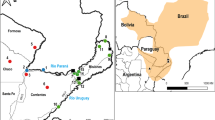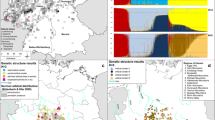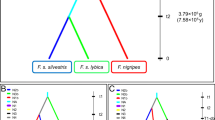Abstract
Despite strong support from the media, the reintroduction of animals into natural environments does not always achieve its goal. Alouatta caraya is the primate species facing the greatest hunting pressure due to the illegal pet trade in Argentina. Confiscations of this species are common, as is the voluntary surrender of animals by owners no longer able or willing to care for them. These animals ultimately arrive at rehabilitation centers and, in many cases, are released into natural environments that may differ from the original sites where they were captured. Until recently, the lack of genetic analysis of the individuals involved led to biased relocation decisions. We followed the reintroduction of 12 A. caraya individuals in a protected area (Isla Palacio, Misiones, Argentina). The presence of potential predators such as pumas (Puma concolor) and jaguars (Panthera onca) in this area was confirmed by camera traps, footprints and feces. After the disappearance of four A. caraya at the reintroduction site, we investigated the applicability of genetic assignment tests based on genotypic data to accurately identify predated individuals. Genetic analyses allowed us to determine the predator species (P. onca) and to identify the predated individuals as two of the reintroduced animals. This procedure is promising for identifying the remains of predated individuals, and can contribute to the design of reintroduction policies based on scientific evidence.


Similar content being viewed by others
References
Anderson CM (1986) Predation and primate evolution. Primates 27:15–39
Baker LR (2002) Guidelines for nonhuman primate re-introductions. Re-introduct NEWS 21:29–57
Bicca-Marques J, Alves SL, Boubli J et al (2020) Alouatta caraya. IUCN Red List Threat Spec 20:e.T41545A17924308. https://doi.org/10.2305/IUCN.UK.2020-2.RLTS.T41545A17924308.en Accessed 23 August 2020
Blair ME, Gutierrez-Espeleta GA, Melnick DJ (2013) Subspecies of the central American Squirrel monkey (Saimiri oerstedii) as units for conservation. Int J Primatol 34(1):86–98
Brown AD, Zunino GE (1994) Hábitat, densidad y problemas de conservación de los primates de la Argentina. Vida Silv Neotrop 3:30–40
Chaves PB, Graeff VG, Lion MB, Oliveira LR, Eizirik E (2012) DNA barcoding meets molecular scatology: short mtDNA sequences for standardized species assignment of carnivore noninvasive samples. Mol Ecol Resour 12:18–35
Coleman RA, Weeks AR, Hoffmann AA (2013) Balancing genetic uniqueness and genetic variation in determining conservation and translocation strategies: a comprehensive case study of threatened dwarf galaxias, Galaxiella pusilla (Mack) (Pisces: Galaxiidae). Mol Ecol 22:1820–1835
Cristóbal-Azkarate J, Urbani B, Asensio N (2015) Interactions of howler monkeys with other vertebrates: a review. In: Kowalewski M, Garber P, Cortés-Ortiz L, Urbani B, Youlatos D (eds) Howler Monkeys. Springer, New York, pp 141–164
Di Fiore A, Fleischer RC (2004) Microsatellite markers for woolly monkeys (Lagothrix lagotricha) and their amplification in other New World primates (Primates: Platyrrhini). Mol Ecol Notes 4:246–249
Edgar RC (2004) MUSCLE: multiple sequence alignment with high accuracy and high throughput. Nucleic Acids Res 32:1792–1797
Emmons LH (1987) Comparative feeding ecology of felids in a neotropical rainforest. Behav Ecol Sociobiol 20:271–283
Estrada A, Garber PA, Rylands AB et al (2017) Impending extinction crisis of the world’s primates: why primates matter. Sci Adv 3(1):e1600946
Farrell LE, Roman J, Sunquist ME (2000) Dietary separation of sympatric carnivores identified by molecular analysis of scats. Mol Ecol 9:1583–1590
Gippoliti S, Cotterill FPD, Zinner D, Groves CP (2018) Poor taxonomy and genetic rescue are possible co-agents of silent extinction and biogeographic homogenization among ungulate mammals. J Integr Biogeog 33:41–54
Green MR, Sambrook J (2012) Molecular cloning: a laboratory manual, 4th edn. Cold Spring Harbor Laboratory Press, New York
Holzmann I, Agostini I, Areta JI et al (2010) Impact of yellow fever outbreaks on two howler monkey species (Alouatta guariba clamitans and A. caraya) in Misiones. Argentina Am J Primatol 72:475–480
Isbell LA (1994) Predation on primates: ecological patterns and evolutionary consequences. Evol Anthrop 3:61–71
IUCN Species Survival Commission (2013) Guidelines for reintroductions and other conservation translocations. Version 1.0. Gland, Switzerland
Jucá T, Boyle S, Cavalcanti G et al (2020) Being hunted high and low: do differences in nocturnal sleeping and diurnal resting sites of howler monkeys (Alouatta nigerrima and Alouatta discolor) reflect safety from attack by different types of predator? Biol J Linn Soc 131:203–219
Junker J, Petrovan SO, Arroyo-Rodríguez V et al (2020) A severe lack of evidence limits effective conservation of the world’s primates. Bioscience 70:794–803
King RA, Read DS, Traugott M, Symondson WOC (2008) INVITED REVIEW: molecular analysis of predation: a review of best practice for DNA-based approaches. Mol Ecol 17:947–963
King T, Chamberlan C, Courage A (2012) Assessing initial reintroduction success in long-lived primates by quantifying survival, reproduction, and dispersal parameters: Western Lowland Gorillas (Gorilla gorilla gorilla) in Congo and Gabon. Int J Primatol 33:134–149
Kleiman DG (1989) Reintroduction of captive mammals for conservation. Bioscience 39:152–161
Ludwig G, Aguiar LM, Miranda JM et al (2007) Cougar predation on black-and-gold howlers on Mutum Island. Southern Brazil Int J Primatol 28:39
Miranda JMD, Bernardi IP, Abreu KC, Passos FC (2005) Predation on Alouatta guariba clamitans Cabrera (Primates, Atelidae) by Leopardus pardalis (Linnaeus) (Carnivora, Felidae). Rev Bras Zool 22:793–795
Miranda JM, Bernardi IP, Moro-Rios RF, Passos FC (2006) Antipredator behavior of brown howlers attacked by black hawk-eagle in Southern Brazil. Int J Primatol 27:1097–1101
Moraes AM, Ruiz-Miranda CR, Ribeiro MC et al (2017) Temporal genetic dynamics of reintroduced and translocated populations of the endangered golden lion tamarin (Leontopithecus rosalia). Conserv Genet 18:995–1009
Moritz C (1999) A molecular perspective on the conservation of diversity. In: Kato S (ed) The biology of biodiversity. Springer, Tokyo, pp 21–34
Neville MK (1972) The population structure of red howler monkeys (Alouatta seniculus) in Trinidad and Venezuela. Folia Primatol 17:56–86
Neville M (1976) The population and conservation of howler monkeys in Venezuela and Trinidad. In: Thorington RW, Heltne PG (eds) Neotropical primates: field studies and conservation. National Academy of Sciences, Washington, pp 101–109
Neville M, Glander K, Braza F, Rylands RA (1988) The howling monkeys, genus Alouatta. Ecol Behav Neotrop Primates 2:349–453
Oklander LI, Marino M, Zunino GE, Corach D (2004) Preservation and extraction of DNA from feces in howler monkeys (Alouatta caraya). Neotrop Primates 12:59–63
Oklander LI, Zunino GE, Di Fiore A, Corach D (2007) Isolation, characterization and evaluation of 11 autosomal STRs suitable for population studies in black and gold howler monkeys Alouatta caraya. Mol Ecol Notes 7:117–120
Oklander LI, Miño CI, Fernández G, Caputo M, Corach D (2017) Genetic structure in the southernmost populations of black-and-gold howler monkeys (Alouatta caraya) and its conservation implications. PLoS ONE 12:e0185867
Oklander LI, Kowalewski MM, Peker S, et al (2019) Alouatta caraya. In: SAYDS - SAREM (ed) Categorización del estado de conservación de los mamíferos de Argentina. Lista Roja de los mamíferos de Argentina. SAREM, Buenos Aires, http://cma.sarem.org.ar/es/especie-nativa/alouatta-caraya. Accessed 28 Dec 2020
Oklander LI, Caputo M, Solari A, Corach D (2020) Genetic assignment of illegally trafficked neotropical primates and implications for reintroduction programs. Sci Rep 10:1–9
Olmos F (1994) Jaguar predation on muriqui Brachyteles arachnoides. Neotrop Primates 2:16
Parson W, Pegoraro K, Niederstätter H, Föger M, Steinlechner M (2000) Species identification by means of the cytochrome b gene. Int J Legal Med 114:23–28
Peetz A, Norconk MA, Kinzey WG (1992) Predation by jaguar on howler monkeys (Alouatta seniculus) in Venezuela. Am J Primatol 28:223–228
Polak T, Saltz D (2011) Re-introduction as an ecosystem restoration technique. Cons Biol 25:424–424
Shanee S (2007) Re-introduction as a tool for primate conservation. Biodiversity 8:43–45
Shehzad W, Riaz T, Nawaz MA et al (2012) Carnivore diet analysis based on next-generation sequencing: application to the leopard cat (Prionailurus bengalensis) in Pakistan. Mol Ecol 21:1951–1965
Szapkievich VB (2000) El Río Paraná como modelador del ambiente de la distribución marginal sur de Alouatta caraya (Primates, Platyrrhini). Doctoral dissertation. Universidad de Buenos Aires, Buenos Aires
Tamura K, Stecher G, Peterson D, Filipski A, Kumar S (2013) MEGA6: molecular evolutionary genetics analysis version 6.0. Mol Biol Evol 30:2725–2729
Tomer Y, Greenberg DA, Concepcion E, Ban Y, Davies TF (2002) Thyroglobulin is a thyroid specific gene for the familial autoimmune thyroid diseases. J Clin Endocr Metab 87:404–407
Torosin NS, Webster TH, Argibay H et al (2020) Positively selected variants in functionally important regions of TLR7 in Alouatta guariba clamitans with yellow fever virus exposure in Northern Argentina. Am J Phys Anthropol 173:50–60
Torres-Florez JP, Johnson WE, Nery MF et al (2018) The coming of age of conservation genetics in Latin America: what has been achieved and what needs to be done. Conserv Genet 19:1–15
Treves A, Drescher A, Ingrisano N (2001) Vigilance and aggregation in black howler monkeys (Alouatta pigra). Behav Ecol Sociobiol 50:90–95
Weeks AR, Sgro CM, Young AG et al (2011) Assessing the benefits and risks of translocations in changing environments: a genetic perspective. Evol Appl 4:709–725
Zuberbuhler K, Jenny D (2002) Leopard predation and primate evolution. J Hum Evol 43:873–886
Acknowledgments
We thank Piers Legh and two anonymous reviewers for thoughtful discussions on the subject and valuable comments on earlier drafts of the manuscript. We greatly appreciate the collaboration with the Ministerio de Ecología y Recursos Sustentables de la Provincia de Misiones, specifically Patricia Sandoval and Cristina Buhler, and the rescue centre Güirá-Oga, particularly Silvia Elsegood and Rocio Rodriguez. LO, MC, MK and DC are members of the Carrera de Investigador (CONICET-Argentina). This work was supported by grants PIP 0914 (CONICET), genuine resources raised by the SHDG and grant 20020170100721BA (UBACyT) to Daniel Corach.
Author information
Authors and Affiliations
Corresponding author
Ethics declarations
Conflict of interest
The authors declare no competing financial and/or non-financial interests in relation to this work.
Additional information
Publisher's Note
Springer Nature remains neutral with regard to jurisdictional claims in published maps and institutional affiliations.
Supplementary Information
Below is the link to the electronic supplementary material.
About this article
Cite this article
Oklander, L.I., Caputo, M., Kowalewski, M. et al. Use of genetic tools to assess predation on reintroduced howler monkeys (Alouatta caraya) in Northeastern Argentina. Primates 62, 521–528 (2021). https://doi.org/10.1007/s10329-021-00896-9
Received:
Accepted:
Published:
Issue Date:
DOI: https://doi.org/10.1007/s10329-021-00896-9




